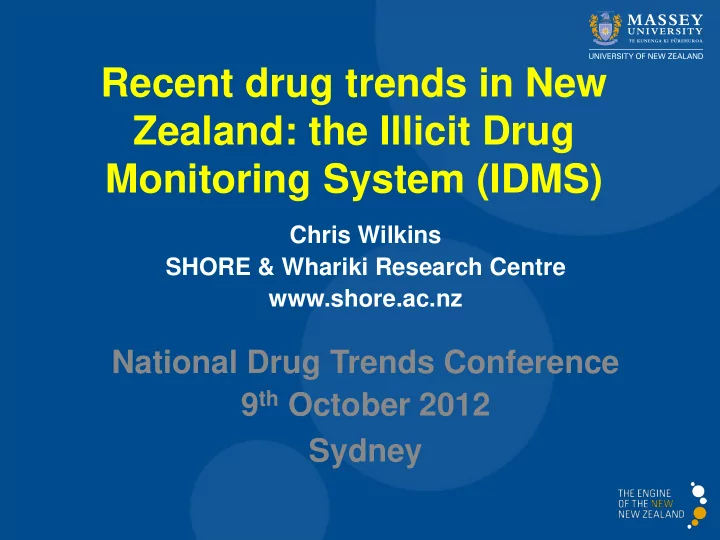

Recent drug trends in New Zealand: the Illicit Drug Monitoring System (IDMS) Chris Wilkins SHORE & Whariki Research Centre www.shore.ac.nz National Drug Trends Conference 9 th October 2012 Sydney
Overview i. The IDMS method ii. Emerging drugs iii.Prohibition of BZP legal highs iv.Conclusions 2
Aims of the IDMS • To track trends in drugs of high concern • To document the availability, price, and potency of drugs • To detect emerging drugs and related problems • Document health and social harms of drug use • To measure the demand for health and treatment services 3
IDMS Method • Drug monitoring must be adapted to drug use patterns, agency and funding environment • Annual targeted survey of frequent drug users • Frequent use (monthly+ in past 6 months) • Conducted in the three main centers (Auckland, Wellington, Christchurch) • Recruited via street level recruitment and ‘snowballing’ • Secondary data sources (i.e. seizures)
How is the IDMS different? • Interview three groups of frequent drug users (i.e. meth, ecstasy and IDU) • Numbers interviewed (300-400 each year) • Greater routine statistical analysis • Market measures (e.g. average price, purchase time) • New drugs (‘drugs used for the first time’) • Weighting of sample by site and drug module • No key experts • Some difference in secondary sources (e.g. calls to drug helpline, admissions to treatment)
New Drugs
% noticed new drug
% who had tried a new drug
% tried new drug by drug user
Drug types ecstasy users used for first time
Drug types meth users used for first time
Drug types IDU used for first time
Drug types used by meth users in past six months
Drug types used by ecstasy users in past six months
Drug types used by IDU in past six months
Means used by meth users to obtain drugs
Means used by ecstasy users to obtain drugs
Means used by IDU to obtain drugs
The prohibition of BZP legal highs
BZP ‘legal highs’ in New Zealand • BZP is mild stimulant (10% potency Dexamphet ) • BZP/TFMPP ‘party pills’ legally sold from 2004 • In 2006, 15% of population aged 13-45 used BZP in previous 12 months, 40% males 18-24 • Estimated 200,000 pills sold every month with annual sales worth $24 million • Wide range of sales outlets (liquor stores, convenience stores, specialty stores, internet) • Manu/sale of BZP prohibited in April 2008 • Moratorium on personal use (100 pills) until October 2008
% general population who stopped using BZP by year they stopped
Reasons for stopping BZP by year stopped Reason 2006 2008 1999-2006 2007-2009 (n=38) (n=37) (n=105) (n=122) % % % % 61 26 58 28 Just don’t like them/ just experimenting 25 18 22 15 Hangover/bad come down effects 5 8 12 11 Health related reasons 9 43 9 30 It’s illegal /under 18 years old/fear of arrest 0 24 3 14 Don’t know where to get it now its illegal
% meth users who used BZP and other drugs
% ecstasy users who used BZP and other drugs
% IDU who used BZP and other drugs
% reported current availability ‘very easy’
% reported drug ‘more difficult’ to obtain
% purchase in one hour or less
Real prices for drugs, 2007-2010 • BZP (per pill) – from $10 in 2007 to $16 in 2010 • Ecstasy (per pill) – from $61 in 2007 to $48 in 2010 • Cannabis (per gram) – from $15 in 2007 to $13 in 2010 • Meth (per gram) – from $1014 in 2007 to $1033 in 2010
% change in real price vs. 2007 prices
% reported price had ‘increased’
Conclusions • Prohibition can reduce the use and availability of legal highs (even with internet supply!) • Price rises and reduced availability can be achieved with very modest enforcement • Other approaches may be effective (e.g. nitrous oxide - Medicines Act) • There may be complicated interactions with black market drugs – BZP sold as ‘ecstasy’ • Were BZP pills replaced with other legal highs? • Did it reduce overall drug related harm?
Thank you Questions welcome! Contact me c.wilkins@massey.ac.nz www.shore.ac.nz
Recommend
More recommend